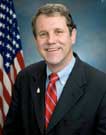|
|
 |
|
The
views expressed
on this page are soley those of the author and do not
necessarily
represent the views of County News Online
|
 |
U.S. Senator Sherrod Brown
Investing in
Ohio's Workforce
Today, President Obama signed into law legislation that contains
provisions modeled after a bill U.S. Sen. Sherrod Brown (D-OH)
introduced that would help dislocated workers acquire the skills for
high-tech jobs in their region.
Included in the signed Workforce Innovation and Opportunity Act (WIOA)
that passed the Senate last month, were provisions from Sen. Brown’s
SECTORS Act, which would promote and require sector-based partnerships
to ensure that workforce training programs are developed with industry
input and tailored to meet companies’ workforce needs. Sen. Brown and
U.S. Sen. Susan Collins (R-ME) introduced the SECTORS Act of 2013 and
successfully fought for similar language in WIOA, which reauthorizes
the Workforce Investment Act (WIA).
Sen Brown touring a Dayton-area industrial maintenance training program
last April.
“With too many Americans still unable to find work, we must do all that
we can to ensure that our workers are qualified to fill available
jobs,” Sen. Brown said. “My SECTORS Act provisions will strengthen job
training efforts and enable U.S. industries like biotechnology, clean
energy, and advanced manufacturing to continue to grow and flourish. I
thank my Congressional colleagues for helping pass my legislation as a
part of the Workforce Innovation and Opportunity Act. And I thank
President Obama for signing this bill into law. Now we must work to
quickly implement the SECTORS Act provisions to address our country’s
skills gap as soon as possible.”
WIA was first passed in 1998 to encourage local businesses to work with
the federal government in developing workforce development that is
customer-focused, gives Americans the resources they need to manage
their careers, and helps American companies find skilled workers. A
recent report found that between 2008 and 2018, Ohio will create
967,000 job openings requiring postsecondary education or training.
Ohio, in fact, ranks tenth with the biggest looming skilled labor
shortage in the country. By tailoring workforce development to the
needs of regional, high-growth industries, more workers could receive
placements and more businesses could be attracted to a region based on
a “clusters” approach.
That is why Sen. Brown successfully fought to pass provisions in WIOA
that would:
Ensure industry stakeholders and business
representatives participate in devising and implementing workforce
training programs;
Require State Workforce Investment Boards to develop
strategies that meet the needs of employers through industry or sector
partnerships related to in-demand industry sectors and occupations; and
Require local employment and training activities to
develop, convene, or implement industry or sector partnerships.
Last year, Sen. Brown introduced the Strengthening Employment Clusters
to Organize Regional Success (SECTORS) Act of 2013. The legislation
would organize stakeholders connected to a regional industry, including
business and labor leaders, education and training providers, and local
workforce and education system administrators, to develop plans for
growing that industry. Sen. Brown’s bill would also address the
disparity between high unemployment rates and a shortage of skilled
workers for many emerging industries by providing grants for sector
partnerships among institutions of higher education, industry,
organized labor, and workforce boards. These partnerships would create
customized solutions for specific industries at the regional level. A
sector approach can focus on the dual goals of promoting the long-term
competitiveness of industries and advancing employment opportunities
for workers.
|
|
|
|

